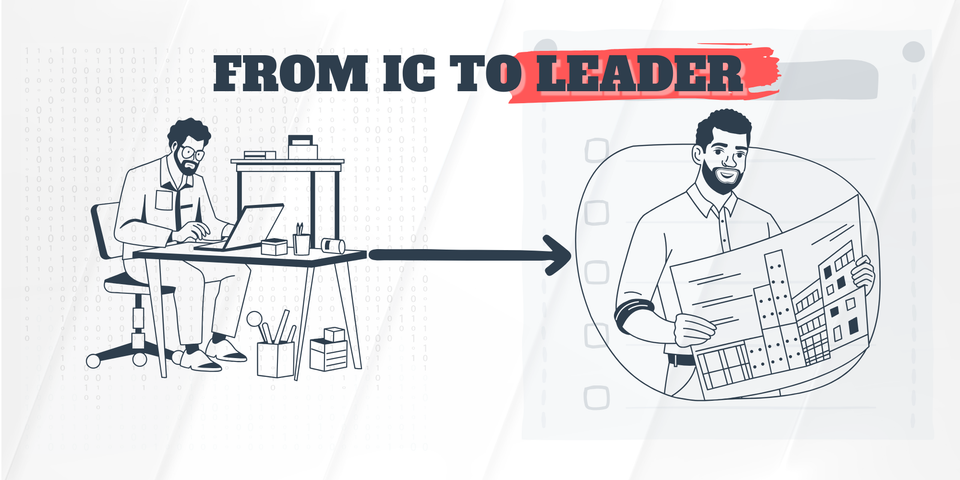From Individual Contributor to Leader: How to Get that Promotion

After coaching dozens of engineers on their transition from individual contributor to leader, I’ve noticed the same pattern repeat itself.
It doesn’t matter if they’re senior backend developers, front-end leads, or staff engineers – the story is always similar.
They’re exceptional at what they do. Reliable, thoughtful, respected by their peers. The kind of people who keep entire systems stable.
And yet – when leadership opportunities appear, they often get passed over.
Not because they lack talent or drive, but because they haven’t learned how to make their impact visible beyond their own work.
A few years ago, I coached an engineer exactly like this. Brilliant technically, but quiet about his achievements. He was the person everyone trusted when things broke, but no one outside the team really knew the depth of his contribution.
When promotion discussions came up, his name didn’t surface – not because he wasn’t performing, but because he wasn’t signaling leadership yet.
He was still operating like an individual contributor – focused on perfect execution, assuming that results would speak for themselves. But leadership isn’t a reward for great work. It’s recognition of broader influence.
We started small. He began mentoring juniors. He volunteered to lead a design review. He documented a complex refactor and presented the impact company-wide.
Six months later, he didn’t just earn a promotion – he earned trust. His peers began looking to him for direction, not just for solutions.
That’s the shift most engineers need to make – from doing great work quietly to leading visibly and intentionally.
And the good news is, it’s a skill you can practice long before you have the title.
Why the Transition Feels Hard
Almost every engineer I coach reaches this same crossroad. They’ve built a strong reputation as dependable, technically sharp, and consistent performers – but when the time comes for leadership roles, something doesn’t click.
It’s not a lack of skill or experience. It’s that invisible gap between doing great work and being seen as someone who can guide others to do great work.
As an individual contributor, success is clear. Your impact is concrete – commits merged, features shipped, issues closed. You can point to a graph or dashboard and say, “I built that.”
But as you begin moving toward leadership, that visibility fades. You stop measuring success by what you directly create and start being measured by what you enable.
That’s an uncomfortable shift for most engineers. It means redefining progress. You’re no longer the hero who fixes everything; you’re the architect who designs the system so others don’t have to.
And that’s where the struggle begins – because the skills that made you successful as an IC aren’t the same ones that will carry you into leadership.
As an IC, you thrive on precision, focus, and ownership. You go deep. You find satisfaction in solving problems yourself.
As a leader, your value lies in breadth, not depth – in communication, delegation, prioritization, and vision. Instead of asking, “How can I fix this?” you start asking, “Who should own this, and how can I help them succeed?”
This transition also challenges something deeper – your sense of identity. Many engineers find pride in being the one others rely on. Letting go of that hands-on control can feel like losing a part of who you are.
And yet, that’s exactly what growth demands.
The most common emotional pattern I see is a mix of doubt and frustration:
- “If I’m already doing well, why isn’t it enough?”
- “What does leadership even mean for someone like me?”
- “How do I prove I’m ready without overstepping?”
The truth is, leadership readiness isn’t something others declare – it’s something you demonstrate through consistent behavior.
That’s why, when I work with engineers at this stage, I encourage one mindset shift above all:
Stop waiting for permission to lead.
Start showing it in how you communicate, mentor, and contribute to the bigger picture. Because leadership isn’t a switch you flip the day you get promoted – it’s a signal you start sending months before anyone notices.
And once people see that signal clearly, the title follows naturally.
The EQ Perspective on the Transition
When engineers begin preparing for leadership, the conversation usually starts with skills: communication, delegation, decision-making. But what truly separates a strong technical lead or new manager from someone who struggles isn’t skill alone – it’s emotional intelligence.
EQ is what helps you make sense of the invisible parts of leadership – the tensions, hesitations, and unspoken expectations that come with influencing people instead of code. It’s what turns technical ability into trustable leadership presence.
From my coaching work with engineers making this shift, four emotional skills consistently make the difference:
1. Self-awareness
The hardest part of leadership is realizing that the problem isn’t always the team – sometimes, it’s your own reactions.
You need to notice when your frustration, need for control, or perfectionism is shaping how you show up. As an IC, you could get away with being reactive; as a leader, your emotions ripple through others. The moment you learn to catch your internal state before it leaks into the room, you start leading with maturity.
2. Empathy
Leadership adds a new layer to your technical world: people. Each person you work with has a different rhythm, motivation, and stress pattern. The more you understand those emotional dynamics, the easier it becomes to coach effectively and prevent unnecessary friction. Empathy isn’t about being “soft” – it’s about reading the human signals that help your team stay aligned and motivated.
3. Perspective
When you’re deep in execution, your world revolves around the task. But leadership requires zooming out – seeing how a single problem connects to the bigger system.
Perspective means asking: How does this decision affect other teams? The product roadmap? The culture we’re creating?
That broader view is what allows leaders to guide with intention rather than firefight endlessly.
4. Adaptability
Leadership doesn’t come with a clean playbook. You’ll face uncertainty, shifting priorities, and moments where no clear answer exists.
Adaptability means being flexible without losing your footing – adjusting your approach to fit the people and the context, not your comfort zone.
These four traits – self-awareness, empathy, perspective, and adaptability – form the emotional foundation of leadership readiness.
They are what make you coachable, what allow others to trust you under pressure, and what give you the calm authority that makes people want to follow your lead.
When technical skill meets emotional depth, that’s when you stop being seen as a strong engineer – and start being seen as a future leader.
6 Practical Steps to Start Leading Before You Have the Title
Once engineers understand that leadership is earned through behavior – not granted through title – everything changes.
The real challenge isn’t waiting for permission. It’s building visible, repeatable habits that make your readiness impossible to ignore.
Here are six concrete ways to start leading now, no matter what your title says:
1. Keep a “brag doc” for your accomplishments
Most engineers underestimate how quickly their impact fades from memory – both theirs and their manager’s. Promotions are built on evidence, not assumptions, and your future self will thank you for keeping detailed records.
Track not just what you did, but why it mattered: performance improvements, design decisions, cross-team collaborations, issues prevented, and measurable outcomes.
The point isn’t ego – it’s clarity. You’re building the habit of evaluating your own work in terms of value, not just effort. That’s the mindset of a leader.
Leaders document their wins not to boast, but to understand where they create the most impact.
2. Practice facilitating meetings
Most engineers think leadership starts in big strategy sessions – it actually starts in the small, everyday interactions where clarity and confidence are built.
Volunteer to facilitate a stand-up, sprint retro, or design review. Your goal isn’t to dominate the conversation but to create structure: make sure everyone’s voice is heard, decisions are captured, and next steps are clear.
When you can turn a scattered 30-minute discussion into a focused 20-minute decision, people start noticing your leadership.
Facilitation is the quiet superpower of great leaders – it’s where influence begins long before authority arrives.
3. Communicate your ambition
Managers aren’t mind readers. Many engineers assume their manager “knows” they want to lead someday. In reality, most managers interpret silence as satisfaction.
Schedule a conversation specifically about growth. Be open and specific:
- “I’m interested in growing into a leadership role. What would readiness look like for my position?”
- “What skills or experiences should I focus on this quarter?”
- “Can we define milestones and check in on progress regularly?”
This turns a vague desire into a shared roadmap. Leadership readiness is a partnership between you and your manager – but it only starts once you say the words out loud.
4. Mentor a junior engineer – or someone from another team
One of the clearest signals of leadership potential is how well you can help others grow. Mentorship is leadership in its most direct form – it builds patience, empathy, and communication skills long before you have managerial authority.
Start small. Offer to guide a new hire through onboarding, pair with a teammate on a complex feature, or help someone outside your immediate team debug an unfamiliar area. You’ll quickly see how influence spreads horizontally before it ever moves vertically.
The goal isn’t to show what you know – it’s to create clarity for someone else.
When you help another engineer succeed, you demonstrate two core traits of leadership: the ability to multiply value and the willingness to serve.
Mentorship is where technical depth meets emotional intelligence – and that combination is what earns trust faster than any title.
5. Create visible technical impact
Pick one critical part of the system that truly matters – something tied to business outcomes, performance, or reliability.
Refactor it, optimize it, or introduce a new tool that improves velocity. But don’t stop once the code is merged.
Document the journey. Create a short internal, company wide, write-up or presentation explaining what changed, why it mattered, and how it improved key metrics. And make sure that key decision makers are on that call.
Visibility isn’t self-promotion – it’s storytelling. It helps others connect your work to the team’s success and positions you as someone who drives results at scale.
6. Build your external leadership identity
Leadership visibility doesn’t stop at your company’s walls. Start sharing your lessons publicly – on LinkedIn, X, or internal blogs. Reflect on how you’re growing, what you’re learning about communication, delegation, or influence.
You don’t need to pretend you’ve “arrived.” Write as a practitioner, not a preacher.
Sharing your perspective attracts other leaders, expands your network, and builds confidence in your own voice.
And every post, comment, or reflection helps you articulate how you think – a key part of leading others.
When you consistently act on these six steps, you stop waiting for recognition and start creating undeniable evidence of leadership readiness.
You prove that you’re already thinking, behaving, and communicating like a leader – long before the title catches up.
The IC → Leader Shift Model
How engineers transform their mindset before the title changes
When I coach engineers through their transition into leadership, I always describe it as a shift in focus rather than a change in role.
You don’t stop being an engineer – you start seeing engineering through a wider lens.
This shift happens gradually, but it’s profound. Here’s how it looks in practice:
| Focus Area | Individual Contributor Mindset | Emerging Leader Mindset |
|---|---|---|
| Ownership | “I own my code and my tasks.” | “I own outcomes – even if others deliver them.” |
| Problem-Solving | “How do I fix this?” | “Who’s best positioned to fix this, and how do I support them?” |
| Communication | Shares updates when asked. | Proactively communicates to align, unblock, and inspire. |
| Impact | Measures success by individual delivery speed and quality. | Measures success by team velocity, clarity, and learning. |
| Recognition | Relies on results to speak for themselves. | Ensures wins are visible and shared across the team. |
| Time Management | Focused on deep work and personal productivity. | Balances execution with coaching, decision-making, and context-setting. |
| Decision-Making | Optimizes for technical perfection. | Optimizes for trade-offs that balance business goals, team capacity, and future scalability. |
| Identity | Pride comes from being the expert. | Pride comes from helping others become experts. |
| Response to Pressure | Doubles down on effort and speed. | Slows down to think systemically and prioritize calmly. |
| Learning | Focused on mastering technology. | Focused on mastering people, systems, and influence. |
This is the real evolution – from crafting solutions to crafting environments where others can create them.
You’ll notice the biggest changes are emotional, not technical.
They’re about shifting from control to trust, from precision to perspective, from doing to enabling.
And that’s why emotional intelligence sits at the center of this model. Without it, you’ll keep trying to lead through skill – when leadership actually happens through presence, communication, and trust.
Practical Tips for Navigating the Transition
Transitioning from IC to leader isn’t a single leap – it’s a series of quiet shifts that build momentum over time.
Here are three ways to keep yourself grounded as you grow:
1. Redefine progress.
Progress no longer means lines of code or completed tickets. It means clarity, trust, and momentum created for others. Learn to celebrate that invisible work.
2. Balance depth with presence.
You’ll still need technical depth, but your real leverage comes from awareness – noticing when to zoom in and when to step back.
3. Reflect weekly.
Ask yourself: “Where did I lead this week – even without being asked?” That question alone builds intentionality faster than any promotion plan.
Final Word
Moving from IC to leader is less about changing what you do – and more about changing how you see.
It’s realizing that leadership isn’t a badge you earn at the end of your technical journey.
It’s a mindset you develop while you’re still in it.
The best leaders I’ve coached didn’t wait for the title.
They built credibility by thinking beyond themselves, one small step at a time.
Do that consistently – and leadership won’t be something you get.
It’ll be something you grow into.
More Ways I Can Support You?
Work With Me 1:1 – Fast-Track Your Leadership Growth!
If you're serious about accelerating your career and becoming the kind of leader people respect and follow, I offer premium 1:1 coaching tailored to your needs. My coaching focuses on:
👥 Build stronger stakeholder relationships!
🗣️ Increase your confidence and influence!
📊 Have higher retention and engagement!
🕊️ Become a smooth conflict resolver!
🚀 Improve your team’s performance!
🌟 Build your leadership reputation!
🎯 Get promoted a lot faster!
🧘 Avoid burnout and stress!
This isn’t just theory, it’s actionable, personalized coaching based on real-world leadership experience.
Let’s Build Emotionally Intelligent Leaders, Together
I’d love to hear from you:
What’s the biggest leadership challenge you’re facing right now?
Hit reply and let me know. I read every response.
If this resonates with you, share this newsletter with a friend or colleague who could benefit from it.
You can also follow me on LinkedIn for more real-world leadership insights.
Let’s build the future of leadership one insight at a time!
Thanks for reading all the way through!
– Djordje
Founder, The Chronicles of a High-EQ Leader.





Member discussion